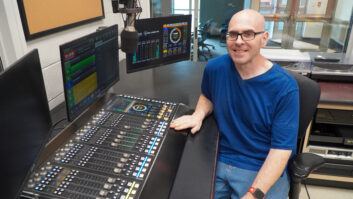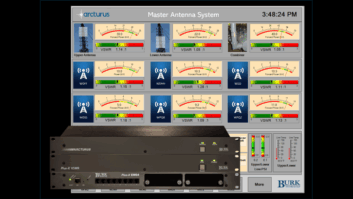The author is senior technologist at NPR Labs in Washington.
Field strength measurements are almost as old as radio itself, as engineers have endeavored to test and improve their RF transmission systems. Despite generations of advancement in radio, however, the principles applied to field strength measurement for broadcast have not changed much.

Left: Fig. 1: A 1948 Ford ‘woody’ station wagon used for the antenna proof of WJZ(TV), Channel 4, Detroit, taken in the winter of 1950–51. Right: Field engineer working in the wagon with the field strength meter (left) and chart recorder (center). Today’s requirements of receiving antennas, detection and filtering, recording and statistical analysis have their basis in principles developed almost three quarters of a century ago. This article discusses some techniques developed by NPR Labs to make FM broadcast field measurements faster, easier and potentially more accurate.
VHF field strength measurements were commonplace at the dawn of television: Every new TV station had to conduct “license proof of performance” tests for their transmission system, which included field measurements to demonstrate that their radiated signal strength was as expected.

Fig. 2: Details of the 1950 measurement system, using a RCA Type 301-B field strength meter containing an attenuator set, tunable RF filter and amplifiers, and detector with DC output; the chart recorder’s movement was linked to the vehicle’s motion, to ensure correlation to the distance traveled in each mobile run. In the 1940s and 1950s, station engineers, or their consultants, carried out extensive measurement programs and filed the results with the FCC. This often required equipping a vehicle with a tall mast and dipole antenna (FCC field strengths are specified at 30 feet above ground) and heavy equipment. An example is the photo in Fig. 1, taken from the proof for WJZ(TV), Channel 4, Detroit, filed Feb. 13, 1950, of a 1948 Ford “woody” station wagon with the dipole mounted above the rear roof. The inset photo shows the interior of the wagon, equipped with a RCA field strength meter and paper chart recorder in the background, operated by an unnamed engineer from William L. Foss Inc. in Washington. Taken in the winter of ’50/’51, that’s Michigan snow under the wagon.
(click thumbnail)
Fig. 3: A chart of one of the radial measurements from WJZ(TV)’s 1950 proof, showing the field strength (vertical scale) vs. distance of many measurement points, with a curve-fit for comparison to the FCC’s (then) field strength prediction curve. Fig. 2 shows the equipment in detail: The RCA Type 301-B field strength meter contained a step attenuator, tunable band pass filter, RF amplifier and detector/filter, which produced a DC output voltage that was proportional to the RF signal voltage. The DC voltage was applied to the chart recorder’s galvanometer, which moved a pen across the paper proportional to the voltage, at right angles to the motion of the paper as it rolled through the recorder. Typically, the winding of the paper was synchronized by speedometer cable to a wheel on the vehicle, so the recording speed was made at a uniform rate of wavelength travelled per second.
Early field strength measurements required numerous (at least a dozen) field strength measurements along a radial from the transmitter. At each location, the vehicle slowly drove a 100-foot mobile run, continuously recording the field strength on the chart paper. Later, the charts were analyzed by hand to determine the median field, and the group of measurements was then plotted as a cluster of points on a chart of distance vs. field strength, as shown in Fig. 3. Taken as a curve through the points, individual variations were minimized and the effect of the antenna’s radiation efficiency could be determined. This process was repeated on numerous other radials to develop an antenna radiation pattern and coverage map. Clearly, this was a laborious and costly process, but it was capable of providing remarkably accurate and repeatable measurements.


Fig. 4: A rental car equipped with NPR Labs’ calibrated ground plane measurement antenna, taking signal and interference measurements near Brush, Colo. Inset: A backseat view of the Field Test Unit, configured for three-signal field strength collection (lower unit) plus HD Radio tracking and data logging (upper unit). Moving to the present, beginning in 2004, NPR Labs needed to collect field strength data from FM radio stations along with reception performance of mobile HD Radio receivers. Instead of 100-foot mobile runs, we needed to gather the signal strength along roadways extending over wide areas of an FM station’s coverage. Rather than estimating the radiation pattern of the station, the purpose of these measurements was to examine the digital receiver’s behavior as a function of field strength, which was valuable in developing a model for predicting HD Radio coverage.
As shown in Fig. 4, NPR’s mode of transportation is more modern, and considerably more comfortable for its field measurements than the 1950-era example. Typically, we use small sedans or crossover SUVs, since the measurement equipment had shrunk to a small box or two that could ride on the back seat, as shown on the inset to Fig. 4; but more on the design of the measurement instrumentation later.

Fig. 5: The modular design of the ground plane antenna is visible in this photo, taken after assembly at Kintronic Labs. A set of standard roof rails attaches the antenna to any vehicle. Modern reference antenna
Based on years of earlier testing with a magnetic mount antenna on the roof of vehicles, we realized that the gain of the antenna seemed to vary from one vehicle to another. This was understandable, since the size, shape and flatness of vehicle roof, which becomes the ground plane of the antenna, differ considerably from one vehicle to another. Equally important, we needed to know the absolute gain of the antenna, to correctly convert received signal power into an ambient field strength.

Fig. 6: The ground plane antenna undergoing calibration on the 30-foot turntable at Table Mountain Test Range, north of Boulder. The horizontal pattern uniformity on the vehicle was performed by rotating the entire vehicle, which contained a reference signal generator, and measuring test signals from a calibrated receive antenna near the measurement van, visible in the background. The solution was the design of a calibrated monopole antenna with a groundplane that “floated” above the roof of the car, helping to isolate it from the car body’s influence. Built by Kintronic Labs, the finished antenna is shown in Fig. 5. It has a circular frame 60 inches in diameter, with an expanded metal mesh ground plane. The ground plane is segmented into four pie-shaped sections that are held together with captive bolts and wing nuts, allowing the antenna to be dismantled quickly and packed in a box for shipment. The ground plane is clamped to roof rails with standard mounts to fit almost any vehicle. We’ve used this antenna on stations from coast to coast, measuring thousands of miles, without a bit of mechanical or electrical trouble. To some, however, it resembled a “flying saucer” hovering over the car, and we’ve received many puzzled looks from other drivers, and even had a few curious police officers ask what we were doing (although, so far, only while we were parked!).
The FM band is covered with a set of four monopoles sized to approximately 1/4 wavelength for each sub-band. The stainless monopoles attach to the center groundplane connector through an insulated base with a series capacitance that counteracts inductive reactance. Kintronic measured each monopole with a network analyzer and trimmed the lengths and capacitance for the best match.

Fig. 7: The ground plane antenna performance as measured on-vehicle at Table Mountain for 87.9, 95.2, 100.6 and 105.6 MHz. The 0-degree reference at the top is the front of the vehicle. An RMS of each pattern was used to determine the calibrated gain for each frequency sub-band. The antenna was calibrated at the Table Mountain Test Range, near Boulder, Colo., operated by the Institute for Telecommunications Science (part of the U.S. Dept. of Commerce). Table Mountain is like the name implies, an eerily flat mesa rising above the Colorado plains — perfect for conducting signal measurement tests without the reflections of buildings, trees or even bushes. As Fig. 6 shows, Table Mountain has a turntable capable of rotating the entire car, which was used for pattern measurements. The inset shows the reverse direction, looking past the test vehicle to the measurement truck and calibrated antenna tower. Fig. 7 shows that the antenna provided good pattern circularity: ±1 dB at 87.9 MHz and ±2.5 dB at 100.6 MHz. Pattern uniformity helps ensure that the gain of the antenna, and its related field strength measurements, are consistent no matter which direction the vehicle is driving, relative to the direction of the transmitter. The RMS gain of the antenna on 72 azimuths was very close to a vertical dipole across the FM band.
Now that an accurate transportable antenna was available, we needed to upgrade our signal measurement instrumentation. The requirements were: (1) a signal meter with wide dynamic range, (2) high selectivity (capable of accurately measuring a desired channel in the vicinity of an undesired first-adjacent channel station), (3) ability to log HD Radio reception (digital/analog blend decision) from the same antenna used for field strength, (4) ability to record field strength on up to three separate channels simultaneously (such as desired channel and upper and lower first-adjacent channels).
This was a tall order, and there was no commercially available unit that met our requirements, so in NPR Labs tradition, we built our own field test unit.
We’ll report on the design, operation and results of the field test unit with the ground plane antenna system when we conclude the story next issue.







